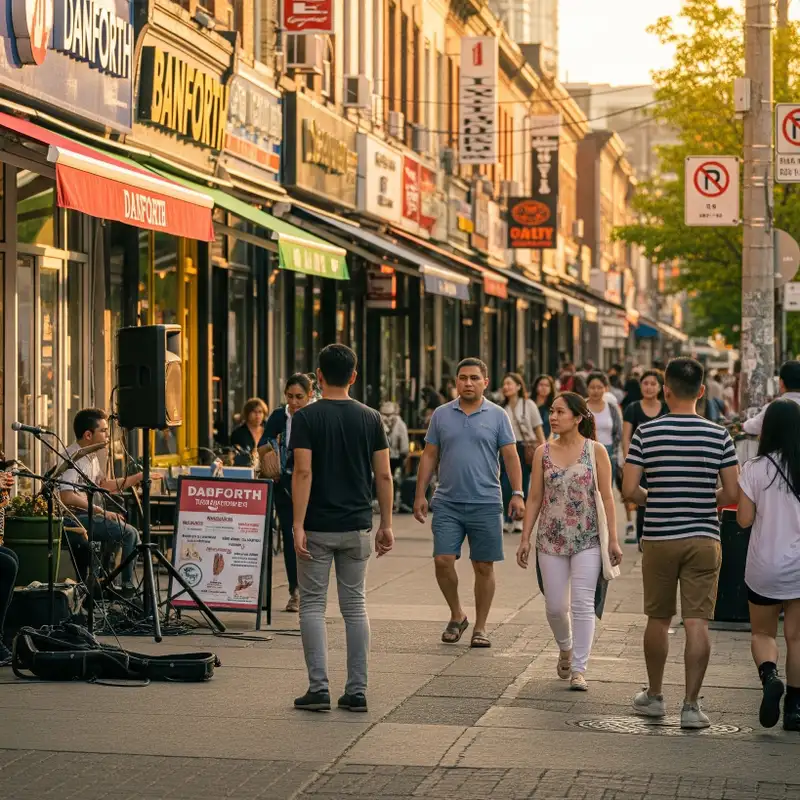Welcome to The Deep Dive. We're
here to cut through the noise and get to what you really need to know.
And today, we're diving deep into the history of Toronto's Danforth.
You probably know it as Greek Town.
Yeah, exactly. But it's, you know, it's more than just a street name.
It's this dynamic story.
It's about how a place gets shaped by, well, geography, big infrastructure projects,
and waves of people settling there.
Our goal today is really to unpack that layered past and understand the vibrant
place it is now. Okay, so let's start right at the beginning.
This land, the Danforth area, it has a really profound indigenous heritage.
We're talking archaeological evidence sharing people lived there continuously for about 7,000 years.
How does that deep history still kind of echo today? Well, it's absolutely an
ongoing part of the story, not just ancient history.
And then you have the road itself, Danforth Avenue.
Funny story there, actually. It's named for Asa Danforth Jr.,
an American contractor.
He got a contract back in 1799, but his work was judged substandard,
like really not good. He never even got fully paid.
Apparently left quite bitter. The road only became, you know,
properly usable way later, 1851. on.
And that was thanks to a totally different group, the Don and Dan Forth Plank Road Company.
So wait, the guy it's named after, his work was substandard and he didn't even finish it properly.
That's quite the historical irony, isn't it? It really is. It kind of makes
you think about how place names sometimes hide the real story, you know? Definitely.
Okay, so moving forward, transportation seems like the real engine here.
How did it go from being this like dusty country road to a major hub?
Right. Transportation was key.
First, you had streetcar lines popping up. The city on Toronto Civic Railway
started the Danforth route in 1913. That was a big step.
The absolute game changer. That was the Prince Edward Viaduct finished in 1919. The viaduct.
Right. Connecting it over the Don Valley. Exactly.
That valley was seen as this like insurmountable obstacle before.
Suddenly the Danforth wasn't isolated anymore. It was directly linked to the downtown core.
And that just unleashed incredible growth. Shops, businesses,
you saw landmarks like Allen's Danforth Theater pop up. That's the Danforth Music Hall now.
It totally transformed the area's vibe. Okay, so that sets the stage.
Now let's talk Greektown. That's the identity everyone knows.
How did that specific cultural concentration come about?
Well, the first wave of non-indigenous settlers were mostly English,
Irish, Scottish immigrants, standard for Toronto at the time.
But then the 1950s, 1960s, you see this huge influx versus Italians and then
a really substantial wave of Greek immigrants.
A lot of them were leaving political and economic trouble back in Greece.
But there's the crucial piece of earlier history here, too. Toronto's first
Greek community, downtown, they experienced these terrible anti-Greek riots
back in 1918, really severe.
Wow. Riots in 1918. That's stark.
So how did that history, plus maybe later economic factors, push the community
towards the Danforth specifically?
It's complex, but definitely connected. So fast forward to 1966,
Bloor-Danforth subway opens.
Big infrastructure project again.
But ironically, taking the streetcars off the surface actually hurt some of
the local street level shops.
Oh, interesting. So the subway was good for commuting, but bad for small shops
right there on the street.
Kind of, yeah. It led to some closures, vacancies, and suddenly rents got cheaper.
And this economic vacuum created an opportunity.
Greek entrepreneurs, many perhaps looking for a space away from the old downtown
core after those earlier troubles, they moved in.
They basically reinvented the street. It shows how planning decisions can have
these totally unexpected cultural impacts. Right. Unintended consequences shaping the neighborhood.
Exactly. And by the 70s, early 80s, the Danforth was huge.
Considered the largest Greek town in North America, some called it Little Athens,
there were maybe 65,000 Greeks living nearby around 1976.
That's incredible growth. And the story is one of adapting, isn't it?
You see it with places like Eastminster United Church offering English classes
for newcomers back in the 50s. right through to places like Access Alliance,
helping diverse communities today. Absolutely.
It's always been adapting. And the avenue itself is now seen as this mixed-use public space.
It actively tries to foster social cohesion.
Think about the taste of the Danforth Festival, right? Huge celebration.
Yeah. Brings everyone together. But connect that to the bigger picture.
Like many mature city neighborhoods, the Danforth is dealing with gentrification now, new growth.
So it's navigating that tension. How do you preserve the historic character,
the cultural diversity, while still evolving?
It's a common challenge everywhere, really.
So looking back at this whole journey, what really stands out,
you've got these ancient indigenous roots, this bizarre story about the namesake,
and then this incredible transformation into a global Greek town.
It feels like a story of resilience, really, continuous reinvention. It really is.
And it leaves us with a pretty important question, I think, something for you,
the listener, to consider. How do communities manage that balancing act.
Celebrating and protecting a specific cherished identity like Greektown,
while also welcoming new people, new development?
How do you make sure that evolution builds on the past rather than erasing it? It's a tough one.
